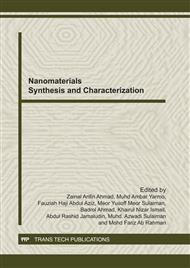p.81
p.86
p.90
p.95
p.100
p.105
p.110
p.115
p.119
Fabrication of ZnO Nanostructures with Self-Cleaning Functionality
Abstract:
The science of biomimicry has served as a fusion point between nature and technology where one could adopt nature’s best solution for human’s use. Lotus leaf, for example, possesses self-cleaning capability due to the unique physical and chemical properties of its surface structural features. In this work, we aimed to mimic these features on glass surface using ZnO nanostructures to achieve the self-cleaning functionality. A series of ZnO films were electrochemically deposited on indium-doped tin oxide (ITO) conducting glass substrates from different aqueous electrolytes at systematically varied deposition potentials and electrolyte conditions. The surface morphology, density, orientation and aspect ratio of the ZnO micro/nanostructures obtained were characterized using X-ray diffraction (XRD) and scanning electron microscopy (SEM). ZnO ranging from two dimensional plate-like to one-dimensional needle-like micro/nanostructures were observed. Results from these studies show that lower electrolyte concentrations tend to favor one-dimensional growth of ZnO nanostructures that self-assembled into micron-size flower-like clusters at higher deposition temperatures. The ZnO-modified hierarchical dual-structured surface exhibits superhydrophobic property with water contact angle as high as 170o.
Info:
Periodical:
Pages:
100-104
Citation:
Online since:
October 2011
Price:
Сopyright:
© 2012 Trans Tech Publications Ltd. All Rights Reserved
Share:
Citation:


